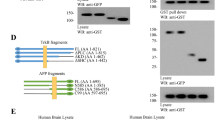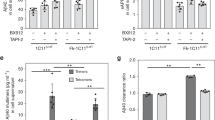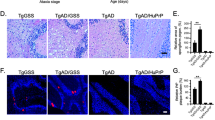Abstract
α-secretase–mediated cleavage of amyloid precursor protein (APP) precludes formation of neurotoxic amyloid-β (Aβ) peptides, and α-cleavage of cellular prion protein (PrPC) prevents its conversion into misfolded, pathogenic prions (PrPSc). The mechanisms leading to decreased α-secretase activity in Alzheimer's and prion disease remain unclear. Here, we find that tumor necrosis factor-α–converting enzyme (TACE)-mediated α-secretase activity is impaired at the surface of neurons infected with PrPSc or isolated from APP-transgenic mice with amyloid pathology. 3-phosphoinositide–dependent kinase-1 (PDK1) activity is increased in neurons infected with prions or affected by Aβ deposition and in the brains of individuals with Alzheimer's disease. PDK1 induces phosphorylation and caveolin-1–mediated internalization of TACE. This dysregulation of TACE increases PrPSc and Aβ accumulation and reduces shedding of TNF-α receptor type 1 (TNFR1). Inhibition of PDK1 promotes localization of TACE to the plasma membrane, restores TACE-dependent α-secretase activity and cleavage of APP, PrPC and TNFR1, and attenuates PrPSc- and Aβ-induced neurotoxicity. In mice, inhibition or siRNA-mediated silencing of PDK1 extends survival and reduces motor impairment following PrPSc infection and in APP-transgenic mice reduces Alzheimer's disease-like pathology and memory impairment.
This is a preview of subscription content, access via your institution
Access options
Subscribe to this journal
Receive 12 print issues and online access
$209.00 per year
only $17.42 per issue
Buy this article
- Purchase on Springer Link
- Instant access to full article PDF
Prices may be subject to local taxes which are calculated during checkout






Similar content being viewed by others
References
Aguzzi, A., Baumann, F. & Bremer, J. The prion's elusive reason for being. Annu. Rev. Neurosci. 31, 439–477 (2008).
Zhang, H., Ma, Q., Zhang, Y.W. & Xu, H. Proteolytic processing of Alzheimer's β-amyloid precursor protein. J. Neurochem. 120 (suppl. 1), 9–21 (2012).
De Strooper, B., Vassar, R. & Golde, T. The secretases: enzymes with therapeutic potential in Alzheimer disease. Nat. Rev. Neurol. 6, 99–107 (2010).
Barger, S.W. & Harmon, A.D. Microglial activation by Alzheimer amyloid precursor protein and modulation by apolipoprotein E. Nature 388, 878–881 (1997).
Meziane, H. et al. Memory-enhancing effects of secreted forms of the β-amyloid precursor protein in normal and amnestic mice. Proc. Natl. Acad. Sci. USA 95, 12683–12688 (1998).
Westergard, L., Turnbaugh, J.A. & Harris, D.A. A naturally occurring, C-terminal fragment of the prion protein delays disease and acts as a dominant negative inhibitor of PrPSc formation. J. Biol. Chem. 286, 44234–44242 (2011).
Edwards, D.R., Handsley, M.M. & Pennington, C.J. The ADAM metalloproteinases. Mol. Aspects Med. 29, 258–289 (2008).
Gooz, M. ADAM-17: the enzyme that does it all. Crit. Rev. Biochem. Mol. Biol. 45, 146–169 (2010).
Vincent, B. et al. The disintegrins ADAM10 and TACE contribute to the constitutive and phorbol ester-regulated normal cleavage of the cellular prion protein. J. Biol. Chem. 276, 37743–37746 (2001).
Buxbaum, J.D. et al. Evidence that tumor necrosis factor α converting enzyme is involved in regulated α-secretase cleavage of the Alzheimer amyloid protein precursor. J. Biol. Chem. 273, 27765–27767 (1998).
Sennvik, K. et al. Levels of α- and β-secretase cleaved amyloid precursor protein in the cerebrospinal fluid of Alzheimer's disease patients. Neurosci. Lett. 278, 169–172 (2000).
Yadavalli, R. et al. Calpain-dependent endoproteolytic cleavage of PrPSc modulates scrapie prion propagation. J. Biol. Chem. 279, 21948–21956 (2004).
Adrain, C., Zettl, M., Christova, Y., Taylor, N. & Freeman, M. Tumor necrosis factor signaling requires iRhom2 to promote trafficking and activation of TACE. Science 335, 225–228 (2012).
D'Alessio, A. et al. Plasma membrane microdomains regulate TACE-dependent TNFR1 shedding in human endothelial cells. J. Cell Mol. Med. 16, 627–636 (2012).
Wang, Y., Herrera, A.H., Li, Y., Belani, K.K. & Walcheck, B. Regulation of mature ADAM17 by redox agents for L-selectin shedding. J. Immunol. 182, 2449–2457 (2009).
Pradines, E. et al. Cellular prion protein coupling to TACE-dependent TNF-α shedding controls neurotransmitter catabolism in neuronal cells. J. Neurochem. 110, 912–923 (2009).
Mouillet-Richard, S. et al. Regulation by neurotransmitter receptors of serotonergic or catecholaminergic neuronal cell differentiation. J. Biol. Chem. 275, 9186–9192 (2000).
Mouillet-Richard, S. et al. Prions impair bioaminergic functions through serotonin- or catecholamine-derived neurotoxins in neuronal cells. J. Biol. Chem. 283, 23782–23790 (2008).
Cronier, S., Beringue, V., Bellon, A., Peyrin, J.M. & Laude, H. Prion strain- and species-dependent effects of antiprion molecules in primary neuronal cultures. J. Virol. 81, 13794–13800 (2007).
MacEwan, D.J. TNF receptor subtype signalling: differences and cellular consequences. Cell Signal. 14, 477–492 (2002).
Mouillet-Richard, S. et al. Signal transduction through prion protein. Science 289, 1925–1928 (2000).
Zhang, Q. et al. Phosphorylation of TNF-α converting enzyme by gastrin-releasing peptide induces amphiregulin release and EGF receptor activation. Proc. Natl. Acad. Sci. USA 103, 6901–6906 (2006).
Pradines, E. et al. Pathogenic prions deviate PrPC signaling in neuronal cells and impair A-β clearance. Cell Death Dis. 4, e456 (2013).
Kloo, B. et al. Critical role of PI3K signaling for NF-κB–dependent survival in a subset of activated B-cell-like diffuse large B-cell lymphoma cells. Proc. Natl. Acad. Sci. USA 108, 272–277 (2011).
Allinson, T.M., Parkin, E.T., Turner, A.J. & Hooper, N.M. ADAMs family members as amyloid precursor protein α-secretases. J. Neurosci. Res. 74, 342–352 (2003).
Laurén, J., Gimbel, D.A., Nygaard, H.B., Gilbert, J.W. & Strittmatter, S.M. Cellular prion protein mediates impairment of synaptic plasticity by amyloid-β oligomers. Nature 457, 1128–1132 (2009).
Benilova, I. & De Strooper, B. Prion protein in Alzheimer's pathogenesis: a hot and controversial issue. EMBO Mol. Med. 2, 289–290 (2010).
Hsiao, K. et al. Correlative memory deficits, Aβ elevation, and amyloid plaques in transgenic mice. Science 274, 99–102 (1996).
Kawarabayashi, T. et al. Age-dependent changes in brain, CSF, and plasma amyloid β protein in the Tg2576 transgenic mouse model of Alzheimer's disease. J. Neurosci. 21, 372–381 (2001).
Manook, A. et al. Small-animal PET imaging of amyloid-β plaques with [11C]PiB and its multi-modal validation in an APP/PS1 mouse model of Alzheimer's disease. PLoS ONE 7, e31310 (2012).
Wesson, D.W. & Wilson, D.A. Age and gene overexpression interact to abolish nesting behavior in Tg2576 amyloid precursor protein (APP) mice. Behav. Brain Res. 216, 408–413 (2011).
Oddo, S. et al. Triple-transgenic model of Alzheimer's disease with plaques and tangles: intracellular Aβ and synaptic dysfunction. Neuron 39, 409–421 (2003).
Oakley, H. et al. Intraneuronal β-amyloid aggregates, neurodegeneration, and neuron loss in transgenic mice with five familial Alzheimer's disease mutations: potential factors in amyloid plaque formation. J. Neurosci. 26, 10129–10140 (2006).
Santuccione, A., Sytnyk, V., Leshchyns'ka, I. & Schachner, M. Prion protein recruits its neuronal receptor NCAM to lipid rafts to activate p59fyn and to enhance neurite outgrowth. J. Cell Biol. 169, 341–354 (2005).
Winklhofer, K.F., Tatzelt, J. & Haass, C. The two faces of protein misfolding: gain- and loss-of-function in neurodegenerative diseases. EMBO J. 27, 336–349 (2008).
Pietri, M. et al. Overstimulation of PrPC signaling pathways by prion peptide 106–126 causes oxidative injury of bioaminergic neuronal cells. J. Biol. Chem. 281, 28470–28479 (2006).
Nixon, R.R. Prion-associated increases in Src-family kinases. J. Biol. Chem. 280, 2455–2462 (2005).
Um, J.W. et al. Alzheimer amyloid-β oligomer bound to postsynaptic prion protein activates Fyn to impair neurons. Nat. Neurosci. 15, 1227–1235 (2012).
Larson, M. et al. The complex PrPc-Fyn couples human oligomeric Aβ with pathological tau changes in Alzheimer's disease. J. Neurosci. 32, 16857–16871 (2012).
Mallucci, G. et al. Depleting neuronal PrP in prion infection prevents disease and reverses spongiosis. Science 302, 871–874 (2003).
Li, R. et al. Tumor necrosis factor death receptor signaling cascade is required for amyloid-β protein–induced neuron death. J. Neurosci. 24, 1760–1771 (2004).
He, P. et al. Deletion of tumor necrosis factor death receptor inhibits amyloid β generation and prevents learning and memory deficits in Alzheimer's mice. J. Cell Biol. 178, 829–841 (2007).
Williams, A., Van Dam, A.M., Ritchie, D., Eikelenboom, P. & Fraser, H. Immunocytochemical appearance of cytokines, prostaglandin E2 and lipocortin-1 in the CNS during the incubation period of murine scrapie correlates with progressive PrP accumulations. Brain Res. 754, 171–180 (1997).
Mehlhorn, G., Hollborn, M. & Schliebs, R. Induction of cytokines in glial cells surrounding cortical β-amyloid plaques in transgenic Tg2576 mice with Alzheimer pathology. Int. J. Dev. Neurosci. 18, 423–431 (2000).
Perry, V.H. The influence of systemic inflammation on inflammation in the brain: implications for chronic neurodegenerative disease. Brain Behav. Immun. 18, 407–413 (2004).
Holmes, C. et al. Systemic inflammation and disease progression in Alzheimer disease. Neurology 73, 768–774 (2009).
Singh, T. & Newman, A.B. Inflammatory markers in population studies of aging. Ageing Res. Rev. 10, 319–329 (2011).
McKhann, G. et al. Clinical diagnosis of Alzheimer's disease: report of the NINCDS-ADRDA Work Group under the auspices of Department of Health and Human Services Task Force on Alzheimer's Disease. Neurology 34, 939–944 (1984).
Vidal, C. et al. Early dnmysfunction of central 5-HT system in a murine model of bovine spongiform encephalopathy. Neuroscience 160, 731–743 (2009).
Baudry, A., Mouillet-Richard, S., Schneider, B., Launay, J.M. & Kellermann, O. miR-16 targets the serotonin transporter: a new facet for adaptive responses to antidepressants. Science 329, 1537–1541 (2010).
Kempster, S., Bate, C. & Williams, A. Simvastatin treatment prolongs the survival of scrapie-infected mice. Neuroreport 18, 479–482 (2007).
Cramer, P.E. et al. ApoE-directed therapeutics rapidly clear β-amyloid and reverse deficits in AD mouse models. Science 335, 1503–1506 (2012).
Brewer, G.J. & Torricelli, J.R. Isolation and culture of adult neurons and neurospheres. Nat. Protoc. 2, 1490–1498 (2007).
Loubet, D. et al. Neuritogenesis: the prion protein controls β1 integrin signaling activity. Faseb J. 26, 678–690 (2012).
McCabe, A., Dolled-Filhart, M., Camp, R.L. & Rimm, D.L. Automated quantitative analysis (AQUA) of in situ protein expression, antibody concentration, and prognosis. J. Natl. Cancer Inst. 97, 1808–1815 (2005).
Mouillet-Richard, S., Laurendeau, I., Vidaud, M., Kellermann, O. & Laplanche, J.L. Prion protein and neuronal differentiation: quantitative analysis of prnp gene expression in a murine inducible neuroectodermal progenitor. Microbes Infect. 1, 969–976 (1999).
Bailly, Y. et al. Prion protein (PrPc) immunocytochemistry and expression of the green fluorescent protein reporter gene under control of the bovine PrP gene promoter in the mouse brain. J. Comp. Neurol. 473, 244–269 (2004).
Heitz, S. et al. BAX contributes to Doppel-induced apoptosis of prion-protein–deficient Purkinje cells. Dev. Neurobiol. 67, 670–686 (2007).
Song, K.S. et al. Co-purification and direct interaction of Ras with caveolin, an integral membrane protein of caveolae microdomains. Detergent-free purification of caveolae microdomains. J. Biol. Chem. 271, 9690–9697 (1996).
Soond, S.M., Everson, B., Riches, D.W.H. & Murphy, G. ERK-mediated phosphorylation of Thr735 in TNF-α–converting enzyme and its potential role in TACE protein trafficking. J. Cell Sci. 118, 2371–2380 (2005).
Slot, J.W., Geuze, H.J., Gigengack, S., Lienhard, G.E. & James, D.E. Immuno-localization of the insulin regulatable glucose transporter in brown adipose tissue of the rat. J. Cell Biol. 113, 123–135 (1991).
Slot, J.W. & Geuze, H.J. A new method of preparing gold probes for multiple-labeling cytochemistry. Eur. J. Cell Biol. 38, 87–93 (1985).
Hofler, A. et al. Study of the PDK1/AKT signaling pathway using selective PDK1 inhibitors, HCS, and enhanced biochemical assays. Anal. Biochem. 414, 179–186 (2011).
Bate, C., Langeveld, J. & Williams, A. Manipulation of PrPres production in scrapie-infected neuroblastoma cells. J. Neurosci. Methods 138, 217–223 (2004).
Raucci, F. et al. Proliferative activity in the frog brain: a PCNA-immunohistochemistry analysis. J. Chem. Neuroanat. 32, 127–142 (2006).
Moss, T.J., Rosenblatt, H.M. & Seeger, R.C. Expression of a developmental stage-specific antigen by neuronal precursor cells of human fetal cerebellum. J. Neuroimmunol. 20, 3–14 (1988).
Schieb, H. et al. β-amyloid peptide variants in brains and cerebrospinal fluid from amyloid precursor protein (APP) transgenic mice: comparison with human Alzheimer amyloid. J. Biol. Chem. 286, 33747–33758 (2011).
Ciccimaro, E. & Blair, I.A. Stable-isotope dilution LC-MS for quantitative biomarker analysis. Bioanalysis 2, 311–341 (2010).
Acknowledgements
We thank G. Bombarde, V. Mutel, F. d'Agostini, G. Zürcher, E. Borroni, J.G. Richards, Z. Lam, M. Bühler, N. Pierron and R. Hochköppler for skillful methodological assistance, C. Vidal for stereotaxic injection of prion strains in mice cerebella, H. Laude and V. Beringue for the use of P3 facilities and F. Brouillard for two-dimensional gel electrophoresis advice. We acknowledge S. Blanquet, M. Briley and A. Baudry for helpful discussions and critical reading of the manuscript. This work was supported by the French Agence Nationale pour la Recherche (Prions&SensiTNF, 1312 01) and INSERM. M.P. is a postdoctoral fellow of French Agence Nationale pour la Recherche. A.A.B. is funded by Domaine d'Intérêt Majeur - Maladies Infectieuses - Région Ile-de-France.
Author information
Authors and Affiliations
Contributions
M.P., J.-M.L., O.K. and B.S. conceptualized the study. M.P., C.D., Y.B., J.-M.P., S.H., A.A.-B., J.H.-R., A.R., S.M.-R., S.H. and B.S. performed experiments, and all authors participated in designing experiments and in analyzing and interpreting data. M.P., O.K. and B.S. wrote the manuscript. J.M.L. and B.S. supervised the project.
Corresponding authors
Ethics declarations
Competing interests
The authors declare no competing financial interests.
Supplementary information
Supplementary Text and Figures
Supplementary Figures 1–12 and Supplementary Tables 1 and 2 (PDF 6384 kb)
Rights and permissions
About this article
Cite this article
Pietri, M., Dakowski, C., Hannaoui, S. et al. PDK1 decreases TACE-mediated α-secretase activity and promotes disease progression in prion and Alzheimer's diseases. Nat Med 19, 1124–1131 (2013). https://doi.org/10.1038/nm.3302
Received:
Accepted:
Published:
Issue Date:
DOI: https://doi.org/10.1038/nm.3302
This article is cited by
-
Increased mutation and gene conversion within human segmental duplications
Nature (2023)
-
Titanium dioxide and carbon black nanoparticles disrupt neuronal homeostasis via excessive activation of cellular prion protein signaling
Particle and Fibre Toxicology (2022)
-
High content screening and proteomic analysis identify a kinase inhibitor that rescues pathological phenotypes in a patient-derived model of Parkinson’s disease
npj Parkinson's Disease (2022)
-
PDK1 is a negative regulator of axon regeneration
Molecular Brain (2021)
-
A rare loss-of-function variant of ADAM17 is associated with late-onset familial Alzheimer disease
Molecular Psychiatry (2020)



